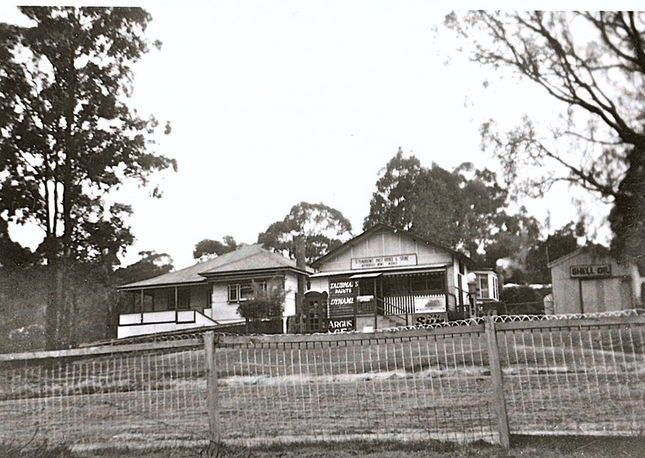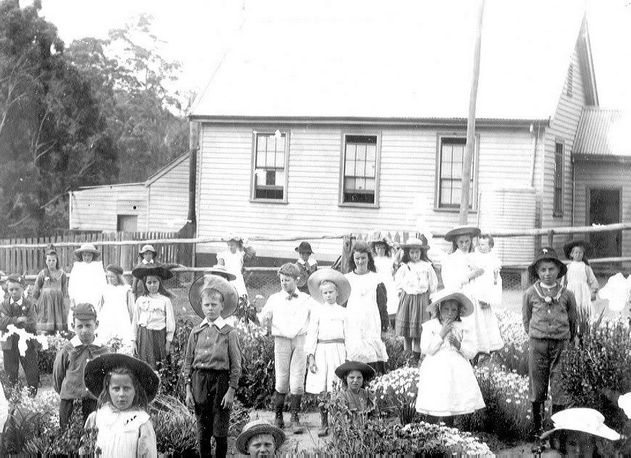
ST ANDREWS / QUEENSTOWN
HISTORICAL SOCIETY
The St Andrews / Queenstown Historical Society and the Queenstown Cemetery play vital roles in keeping the stories of our district alive. From gold rush beginnings to thriving orchards, from pioneer schools to sacred burial grounds, these local heritage efforts invite you to explore, reflect, and connect.
We respectfully acknowledge the Wurundjeri Woi Wurrung people of the Kulin Nation, Traditional Custodians of the land on which St Andrews stands. They lived, cared for and gathered on this land for over 30,000 years — a legacy still present in the native bush and wildlife we treasure today.
ABOUT St Andrews /
Queenstown Historical Society
The St Andrews & Queenstown Historical Society was formed in 1998 with the goal of collecting, preserving, and sharing the history of the district. We began with photos, documents, and oral histories — and we continue this work today with the help of technology, local knowledge, and collaboration.
The society welcomes new members, especially those who would like to share memories, photos, or stories that enrich our community’s understanding of the past. We meet every second month on Saturday mornings at 9:30am, and everyone is welcome.
Membership fees
-
Single: $12 per year
-
Family: $15 per year
Contact us
Email: standrewscommunitycentre@gmail.com
Phone: 9710 1519
President: Helen Kenney
Secretary: Gaye Ponting
HISTORICAL HIGHLIGHTS
of St Andrews / Queenstown
ABORIGINAL HERITAGE
The first people to move across this land were the Aboriginal people, known as the Wurundjeri. They lived in harmony with the land and its seasons for thousands of years.
In 1835, the ‘township’ of Melbourne was claimed by Europeans, and 40,000 years of continuous living was disrupted for the Wurundjeri.
A window into their way of life can still be glimpsed through the native bush and animals that remain in the district today.
GOLD
European settlement began in this district in late 1853–1854 with the discovery of gold in Spanish Gully at Smiths Gully by George Boston and his party. The first gold in the region had been discovered in Warrandyte in 1851. The area stretching from Warrandyte to Queenstown became known as the Caledonian Diggings and formed part of the St Andrews Mining Division.
Within months of this discovery, a mining village sprang up at the rush to Caledonia, known as Market Square — located opposite what is now the Queenstown Cemetery. Gold was being extracted from One Tree Hill and from the many gullies and creeks in the surrounding area.
Some of the mining claims, reefs, and companies were given colourful names — Old Boomer, New Boomer, Perseverance, The Late Hustlers, Eureka, Welcome Reef, Lancashire Hero, Slaughter Yard Rush, and Never-Too-Late-to-Mend!
By 1864, 45 reefs had been totally abandoned.
Records from around 1890 show that nearly 25,000 ounces of gold had been extracted from quartz reefs, including:
-
Yow Yow – 7,500 oz
-
One Tree Hill – 7,500 oz
-
Panton Hill (Orams Reef) – 9,000 oz

ORCHARDS
As the gold ran out, some families — the Ninks, Mullers, Sabelbergs, Cant, Dugdale, and Mittons — stayed and turned their talents to farming the land. There were many orchards growing a variety of fruit: apples, pears, plums, peaches, quinces, raspberries, and strawberries.
The Ninks were known as the Peach Kings — they grew the best peaches. They also grew grapes, not for wine, but for the leaves. Each peach was individually wrapped in a grape leaf, making the presentation of the fruit more attractive and helping them fetch a higher price at market.
ST ANDREWS CHURCH
The church was built in 1868, and the Dean of Melbourne gave the opening service in 1869. It was reported in the Melbourne Church News that it was built on the best site in the township. The following morning, a tea meeting was held — the ladies performed their part well and spared no cost or effort in spreading the tables with a most sumptuous repast, to which about 200 people sat down.
In the early 1880s, the minister travelled to give services in Panton Hill, Christmas Hills, Upper Diamond Creek, Smiths Gully, and Queenstown. In later years, after St Matthews was opened, he no longer visited Panton Hill but made his way up the mountain to Kinglake.
In 1889, a parsonage was built. Over the years, this served as the residence for the minister and later became a rental property for local families. It gradually fell into disrepair and was condemned by the Shire. In the early 1970s, it was burnt down by the local CFA as a training exercise.
ST ANDREWS
POST OFFICE & HOTEL
The post office began in 1856, established by W. Watson and Sons, and was leased to William Morton, who was paid an annual salary of ₤100.
In 1857, John Corke Knell took over. Nine years later, he applied for a licence for the St Andrews Hotel, which still stands on the same site today. John died in 1867.
His wife Eliza took over running the establishment. In 1869, she remarried Robert Smith. Eliza also served as the registrar for births, deaths and marriages. The hotel and post office remained in Eliza’s family for 60 years.
Eliza was a well-respected figure in the town. She died in 1911, aged 74, and is buried in Queenstown Cemetery.
A local named "Barney" made the following comment in 1882:
“That some people seem to think that the ‘pub’ is a fit and proper place for church, parsonage, school, mechanic’s institute, and all public business.”
Opposite the hotel was the Police Paddocks. The police station was operational in the late 1850s, with one mounted constable and one senior foot constable. The Court of Petty Sessions began in 1861 and serviced the district for 30 years. Most cases were minor — such as sly grog selling, drunk and disorderly conduct, and fines for not vaccinating children or failing to send them to school.
The police station ceased operating in 1917. In 1920, the police quarters were moved to Doncaster East School, where they were repurposed as a teacher’s residence.
QUEENSTOWN STATE SCHOOL 128
The school began as Caledonia Diggings in 1858. Allegedly, classes were first held in a tent, then in a hut on the main road, on the left before Buttermans Track.
In 1882, a new school building and residence were constructed at the current site, on the corner of Caledonia Street and School Road — the location now occupied by the Wadambuk St Andrews Community Centre. The building had originally been constructed in Smiths Gully in 1876, then relocated to St Andrews.
In 1984, the new St Andrews Primary School was built in its current location next door.
The old school building became the St Andrews Community Centre in 1983.
QUEENSTOWN CEMETERY
The Queenstown Cemetery is a significant site located in Smiths Gully. Established after the gold rush, it became the Cemetery for the Caledonian Diggings. It holds over 380 burials, including Chinese miners, early German and English settlers, and other locals who contributed to the community’s early development.
Key milestones in the history of Queenstown Cemetery include:
-
1861: The first recorded burial.
-
1866: Officially declared a Cemetery Reserve.
-
1948: The Trusteeship of the Cemetery was transferred to the Shire of Eltham.
-
1951: Official closure for new burials.
-
2000: Registered as “Land for Wildlife”.
-
2008: Memorial Cairn established in honor of the miners and pioneers of the district.
The cemetery is located on 1.7 hectares of regrowth bushland, and it includes a range of significant indigenous species. The heritage vegetation and the graves themselves are protected, and the cemetery serves as a reminder of the area’s rich history.
Accessing Queenstown Cemetery
To explore the plot map or view deceased records, you can access the Cemetery Map online. This feature, powered by Chronicle, offers valuable information about the graves and individuals buried in Queenstown Cemetery.
For more information or inquiries about the cemetery, please contact us via email or attend a St Andrews/Queenstown Historical Society meeting.
ARTIST COLLABORATION:
“Anonymous Sojourners in the Australian Bush”
In 2017, artist Dr Tammy Wong Hulbert, in collaboration with the St Andrews Men’s Shed, St Andrews/Queenstown Historical Society, and Wadambuk Arts Group, created a project called "Anonymous Sojourners in the Australian Bush." This art installation at Wadambuk St Andrews Community Centre highlighted the untold stories of the Chinese miners buried in the Queenstown Cemetery. The exhibit aimed to bring attention to the Chinese community's contribution and recognition of their often-unmarked graves in the area.
Many Chinese miners came as sojourners — temporary migrants who hoped to earn money in Australia before returning home. Sadly, many did not survive the harsh conditions and were buried in unmarked graves, with little record of their contributions to the district.




































